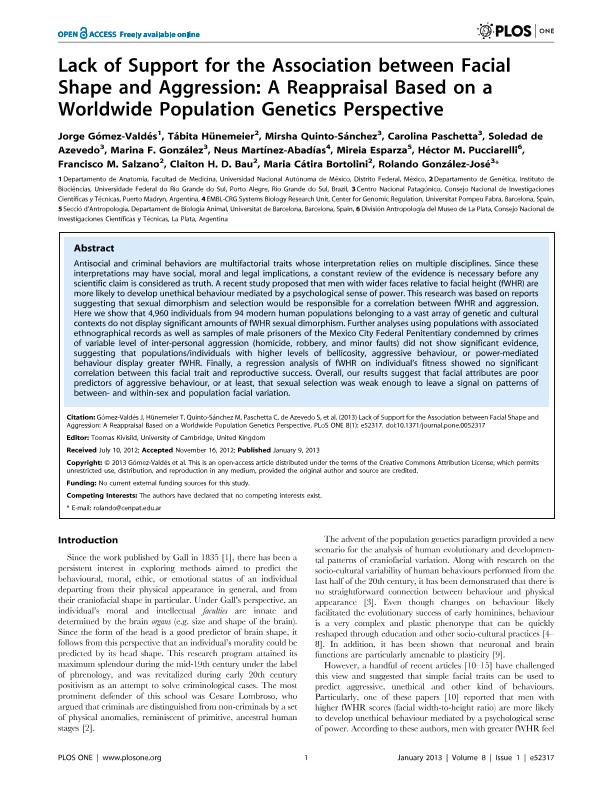Mostrar el registro sencillo del ítem
dc.contributor.author
Goméz Valdés, Jorge
dc.contributor.author
Hünemeier, Tábita
dc.contributor.author
Quinto Sanchez, Mirsha Emmanuel

dc.contributor.author
Paschetta, Carolina Andrea

dc.contributor.author
de Azevedo, Soledad

dc.contributor.author
González, Marina Fernanda

dc.contributor.author
Martínez Abadías, Neus
dc.contributor.author
Esparza, Mireira
dc.contributor.author
Pucciarelli, Hector Mario

dc.contributor.author
Salzano, Francisco M.
dc.contributor.author
Bau, Claiton H. D.
dc.contributor.author
Bortolini, Maria Catira

dc.contributor.author
González José, Rolando

dc.date.available
2018-08-09T20:43:32Z
dc.date.issued
2013-01
dc.identifier.citation
Goméz Valdés, Jorge; Hünemeier, Tábita; Quinto Sanchez, Mirsha Emmanuel; Paschetta, Carolina Andrea; de Azevedo, Soledad; et al.; Lack of Support for the Association between Facial Shape and Aggression: A Reappraisal Based on a Worldwide Population Genetics Perspective; Public Library of Science; Plos One; 8; 1; 1-2013; e52317
dc.identifier.issn
1932-6203
dc.identifier.uri
http://hdl.handle.net/11336/54886
dc.description.abstract
Antisocial and criminal behaviors are multifactorial traits whose interpretation relies on multiple disciplines. Since these interpretations may have social, moral and legal implications, a constant review of the evidence is necessary before any scientific claim is considered as truth. A recent study proposed that men with wider faces relative to facial height (fWHR) are more likely to develop unethical behaviour mediated by a psychological sense of power. This research was based on reports suggesting that sexual dimorphism and selection would be responsible for a correlation between fWHR and aggression. Here we show that 4,960 individuals from 94 modern human populations belonging to a vast array of genetic and cultural contexts do not display significant amounts of fWHR sexual dimorphism. Further analyses using populations with associated ethnographical records as well as samples of male prisoners of the Mexico City Federal Penitentiary condemned by crimes of variable level of inter-personal aggression (homicide, robbery, and minor faults) did not show significant evidence, suggesting that populations/individuals with higher levels of bellicosity, aggressive behaviour, or power-mediated behaviour display greater fWHR. Finally, a regression analysis of fWHR on individual's fitness showed no significant correlation between this facial trait and reproductive success. Overall, our results suggest that facial attributes are poor predictors of aggressive behaviour, or at least, that sexual selection was weak enough to leave a signal on patterns of between- and within-sex and population facial variation. © 2013 Gómez-Valdés et al.
dc.format
application/pdf
dc.language.iso
eng
dc.publisher
Public Library of Science

dc.rights
info:eu-repo/semantics/openAccess
dc.rights.uri
https://creativecommons.org/licenses/by-nc-sa/2.5/ar/
dc.subject
Multifactorial Traits
dc.subject
Multiple Disciplines
dc.subject
Facial Height
dc.subject
Sexual Dimorphism
dc.subject.classification
Otras Ciencias Biológicas

dc.subject.classification
Ciencias Biológicas

dc.subject.classification
CIENCIAS NATURALES Y EXACTAS

dc.title
Lack of Support for the Association between Facial Shape and Aggression: A Reappraisal Based on a Worldwide Population Genetics Perspective
dc.type
info:eu-repo/semantics/article
dc.type
info:ar-repo/semantics/artículo
dc.type
info:eu-repo/semantics/publishedVersion
dc.date.updated
2018-07-23T17:29:02Z
dc.journal.volume
8
dc.journal.number
1
dc.journal.pagination
e52317
dc.journal.pais
Estados Unidos

dc.journal.ciudad
San Francisco
dc.description.fil
Fil: Goméz Valdés, Jorge. Universidad Nacional Autónoma de México; México
dc.description.fil
Fil: Hünemeier, Tábita. Universidade Federal do Rio Grande do Sul; Brasil
dc.description.fil
Fil: Quinto Sanchez, Mirsha Emmanuel. Consejo Nacional de Investigaciones Científicas y Técnicas. Centro Nacional Patagónico; Argentina
dc.description.fil
Fil: Paschetta, Carolina Andrea. Consejo Nacional de Investigaciones Científicas y Técnicas. Centro Nacional Patagónico; Argentina
dc.description.fil
Fil: de Azevedo, Soledad. Consejo Nacional de Investigaciones Científicas y Técnicas. Centro Nacional Patagónico; Argentina
dc.description.fil
Fil: González, Marina Fernanda. Consejo Nacional de Investigaciones Científicas y Técnicas. Centro Nacional Patagónico; Argentina
dc.description.fil
Fil: Martínez Abadías, Neus. Universitat Pompeu Fabra; España
dc.description.fil
Fil: Esparza, Mireira. Universidad de Barcelona. Facultad de Biología. Departamento de Biología Animal; España
dc.description.fil
Fil: Pucciarelli, Hector Mario. Consejo Nacional de Investigaciones Científicas y Técnicas. Centro Científico Tecnológico Conicet - La Plata; Argentina
dc.description.fil
Fil: Salzano, Francisco M.. Universidade Federal do Rio Grande do Sul; Brasil
dc.description.fil
Fil: Bau, Claiton H. D.. Universidade Federal do Rio Grande do Sul; Brasil
dc.description.fil
Fil: Bortolini, Maria Catira. Universidade Federal do Rio Grande do Sul; Brasil
dc.description.fil
Fil: González José, Rolando. Consejo Nacional de Investigaciones Científicas y Técnicas. Centro Nacional Patagónico; Argentina
dc.journal.title
Plos One

dc.relation.alternativeid
info:eu-repo/semantics/altIdentifier/url/http://journals.plos.org/plosone/article?id=10.1371/journal.pone.0052317
dc.relation.alternativeid
info:eu-repo/semantics/altIdentifier/doi/http://dx.doi.org/10.1371/journal.pone.0052317
Archivos asociados
